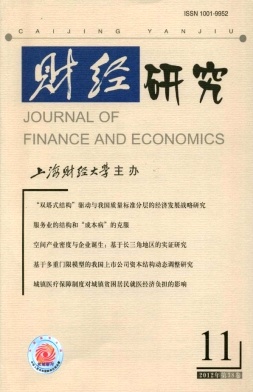冗余资源对金融危机时期企业绩效和投资效果的影响
财经研究 2012 年 第 38 卷第 11 期, 页码:135 - 145
摘要
参考文献
摘要
关于冗余资源作用争议的解决需要结合具体情境进行分类研究。近年来的全球性金融危机是一种典型的环境变化,文章以此为背景,利用我国1 107家A股上市公司2006-2009年的面板数据,对冗余资源的缓冲作用进行检验,并证实:非沉淀冗余资源在正常时期发挥更大的效用,而沉淀冗余资源在金融危机时期发挥更大的效用;相比正常时期,金融危机情境下的投资效果变差,非沉淀冗余资源的存在会进一步恶化投资效果,沉淀冗余资源所起的作用恰好相反。这说明环境变化致使冗余资源的作用发生改变,只有沉淀冗余资源才具有缓冲作用,而非沉淀冗余资源的存在则会增加投资的盲目性,在金融危机情境下更是如此。
[1]程志强.资源诅咒假说:一个文献综述[J].财经问题研究,2008,(3):20-24.
[2]蒋春燕,赵曙明.组织冗余与绩效的关系:中国上市公司的时间序列实证研究[J].管理世界,2004,(5):108-115.
[3]中国经济增长与宏观稳定课题组.全球失衡、金融危机与中国经济的复苏[J].经济研究,2009,(5):4-20.
[4]Auty R M.Sustaining development in mineral economics:The resource curse thesis[M].London:Routledge,1993.
[5]Bourgeois L J.On the measurement of organizational slack[J].Academy of Manage-ment Review,1981,6(1):29-39.
[6]Chattopadhyay P,Glick W H,Huber G P.Organizational actions in response to threats and opportunities[J].Academy of Management Journal,2001,44(5):937-955.
[7]Cheng J L C,Kesner I F.Organizational slack and response to environmental shifts:The im-pact of resource allocation patterns[J].Journal of Management,1997,23(1):1-18.
[8]Cyert R,March J.A behavioral theory of the firm[M].Englewood Cliffs,NJ:Pren-tice-Hall,1963.
[9]Gylfason T.Natural resources,education and economic development[J].European Economic Review,2001,45(4-6):847-859.
[10]Haveman H A,Russo M V,Meyer A D.Organizational environments in flux:The impact of regulatory punctuations on organizational domains,CEO succession,and per-formance[J].Organization Science,2001,12(3):253-273.
[11]Jensen M.Agency costs of free cash flow,corporate finance and takeovers[J].Ameri-can Economics Review,1986,76(2):323-329.
[12]Miller K D,Chen W R.Variable organizational risk preferences:Tests of the March-Shapira model[J].Academy of Management Journal,2004,47(1):105-115.
[13]Rodriguez F,Sachs J D.Why do resource-abundant economies grow more slowly?[J].Journal of Economic Growth,1999,4(3):277-303.
[14]Sharfman M P,Wolf G,Chase R B,Tansik D A.Antecedents of organizational slack[J].Academy of Management Review,1988,13(4):601-614.
[15]Summers L H.International financial crises:Causes,prevention,and cures[J].American Economic Review,2000,90(2):1-16.
[16]Tan J,Peng M.Organizational slack and firm performance during economic transi-tions:Two studies from an emerging economy[J].Strategic Management Journal,2003,24(13):1249-1263.
[17]Tan H H,See H H.Strategic reorientation and responses to the Asian financial crisis:The case of the manufacturing industry in Singapore[J].Asia Pacific Journal of Management,2004,21(1-2):189-211.
[18]Wan W P,Yiu D W.From crisis to opportunity:Environmental jolt,corporate acquisi-tions,and firm performance[J].Strategic Management Journal,2009,30(7):791-801.
[19]Wiseman R,Catanach A.A longitudinal disaggregation of operation risk under changing regulations:Evidence from the savings and loan industry[J].Academy of Management Jour-nal,1997,40(4):799-830.
[2]蒋春燕,赵曙明.组织冗余与绩效的关系:中国上市公司的时间序列实证研究[J].管理世界,2004,(5):108-115.
[3]中国经济增长与宏观稳定课题组.全球失衡、金融危机与中国经济的复苏[J].经济研究,2009,(5):4-20.
[4]Auty R M.Sustaining development in mineral economics:The resource curse thesis[M].London:Routledge,1993.
[5]Bourgeois L J.On the measurement of organizational slack[J].Academy of Manage-ment Review,1981,6(1):29-39.
[6]Chattopadhyay P,Glick W H,Huber G P.Organizational actions in response to threats and opportunities[J].Academy of Management Journal,2001,44(5):937-955.
[7]Cheng J L C,Kesner I F.Organizational slack and response to environmental shifts:The im-pact of resource allocation patterns[J].Journal of Management,1997,23(1):1-18.
[8]Cyert R,March J.A behavioral theory of the firm[M].Englewood Cliffs,NJ:Pren-tice-Hall,1963.
[9]Gylfason T.Natural resources,education and economic development[J].European Economic Review,2001,45(4-6):847-859.
[10]Haveman H A,Russo M V,Meyer A D.Organizational environments in flux:The impact of regulatory punctuations on organizational domains,CEO succession,and per-formance[J].Organization Science,2001,12(3):253-273.
[11]Jensen M.Agency costs of free cash flow,corporate finance and takeovers[J].Ameri-can Economics Review,1986,76(2):323-329.
[12]Miller K D,Chen W R.Variable organizational risk preferences:Tests of the March-Shapira model[J].Academy of Management Journal,2004,47(1):105-115.
[13]Rodriguez F,Sachs J D.Why do resource-abundant economies grow more slowly?[J].Journal of Economic Growth,1999,4(3):277-303.
[14]Sharfman M P,Wolf G,Chase R B,Tansik D A.Antecedents of organizational slack[J].Academy of Management Review,1988,13(4):601-614.
[15]Summers L H.International financial crises:Causes,prevention,and cures[J].American Economic Review,2000,90(2):1-16.
[16]Tan J,Peng M.Organizational slack and firm performance during economic transi-tions:Two studies from an emerging economy[J].Strategic Management Journal,2003,24(13):1249-1263.
[17]Tan H H,See H H.Strategic reorientation and responses to the Asian financial crisis:The case of the manufacturing industry in Singapore[J].Asia Pacific Journal of Management,2004,21(1-2):189-211.
[18]Wan W P,Yiu D W.From crisis to opportunity:Environmental jolt,corporate acquisi-tions,and firm performance[J].Strategic Management Journal,2009,30(7):791-801.
[19]Wiseman R,Catanach A.A longitudinal disaggregation of operation risk under changing regulations:Evidence from the savings and loan industry[J].Academy of Management Jour-nal,1997,40(4):799-830.
引用本文
李晓翔, 刘春林. 冗余资源对金融危机时期企业绩效和投资效果的影响[J]. 财经研究, 2012, 38(11): 135–145.
导出参考文献,格式为:
本期封面
相关论文





 7536
7536  4035
4035

